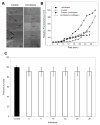Aberrant glycosylation in the human trabecular meshwork
- PMID: 24458570
- PMCID: PMC4015974
- DOI: 10.1002/prca.201300031
Aberrant glycosylation in the human trabecular meshwork
Abstract
Purpose: To determine the difference in protein glycosylation and glycosylation enzyme levels between glaucomatous and control trabecular meshwork (TM).
Experimental design: Glaucomatous and normal donor (n = 12 each) TM tissues, lectin fluorescence, fluorophore-assisted carbohydrate analyses, and quantitative MS were used to determine the glycosylation levels. Primary TM cells and glycosylation inhibitors were used to determine their effect on cell shape and motility.
Results: In contrast to elevated levels of glycoproteins determined by lectin fluorescence, simultaneous hyper- and hypo-glycosylation in glaucomatous TM was revealed by fluorophore-assisted carbohydrate analyses. Analyses of enzymes showed elevation of beta-glycosidase 1 and decrease in galactosyltransferase family 6 domain containing protein 1 in the glaucomatous TM. Quantitative MS identified select protein level changes between glaucomatous and normal TM. Primary TM cells were treated with inhibitors to elicit hypo-glycosylation, which affected cell shape, motility, and fluorescent tracer transport across a layer of TM cells.
Conclusions and clinical relevance: Global protein glycosylation is aberrant in glaucomatous TM compared to controls. The results presented here suggest that the alteration in global TM protein glycosylation encompassing cellular and extracellular matrix proteins contributes to glaucoma pathology likely mediated through changes in properties of TM cells.
Keywords: Carbohydrate electrophoresis; Glaucoma; Glycosylation; Trabecular meshwork.
© 2014 WILEY-VCH Verlag GmbH & Co. KGaA, Weinheim.
Figures



References
-
- Stadtman ER. Protein modification in aging. J Gerontol. 1988;43:B112–B20. - PubMed
-
- Bhattacharya SK. Retinal deimination in aging and disease. IUBMB Life. 2009;61:504–9. - PubMed
-
- Jaisson S, Gillery P. Evaluation of nonenzymatic posttranslational modification-derived products as biomarkers of molecular aging of proteins. Clin Chem. 2010;56:1401–12. - PubMed
-
- Morrison JC, Johnson EC, Cepurna W, Jia L. Understanding mechanisms of pressure-induced optic nerve damage. Prog Retin Eye Res. 2005;24:217–40. - PubMed
Publication types
MeSH terms
Substances
Grants and funding
LinkOut - more resources
Full Text Sources
Other Literature Sources
Medical
Research Materials

